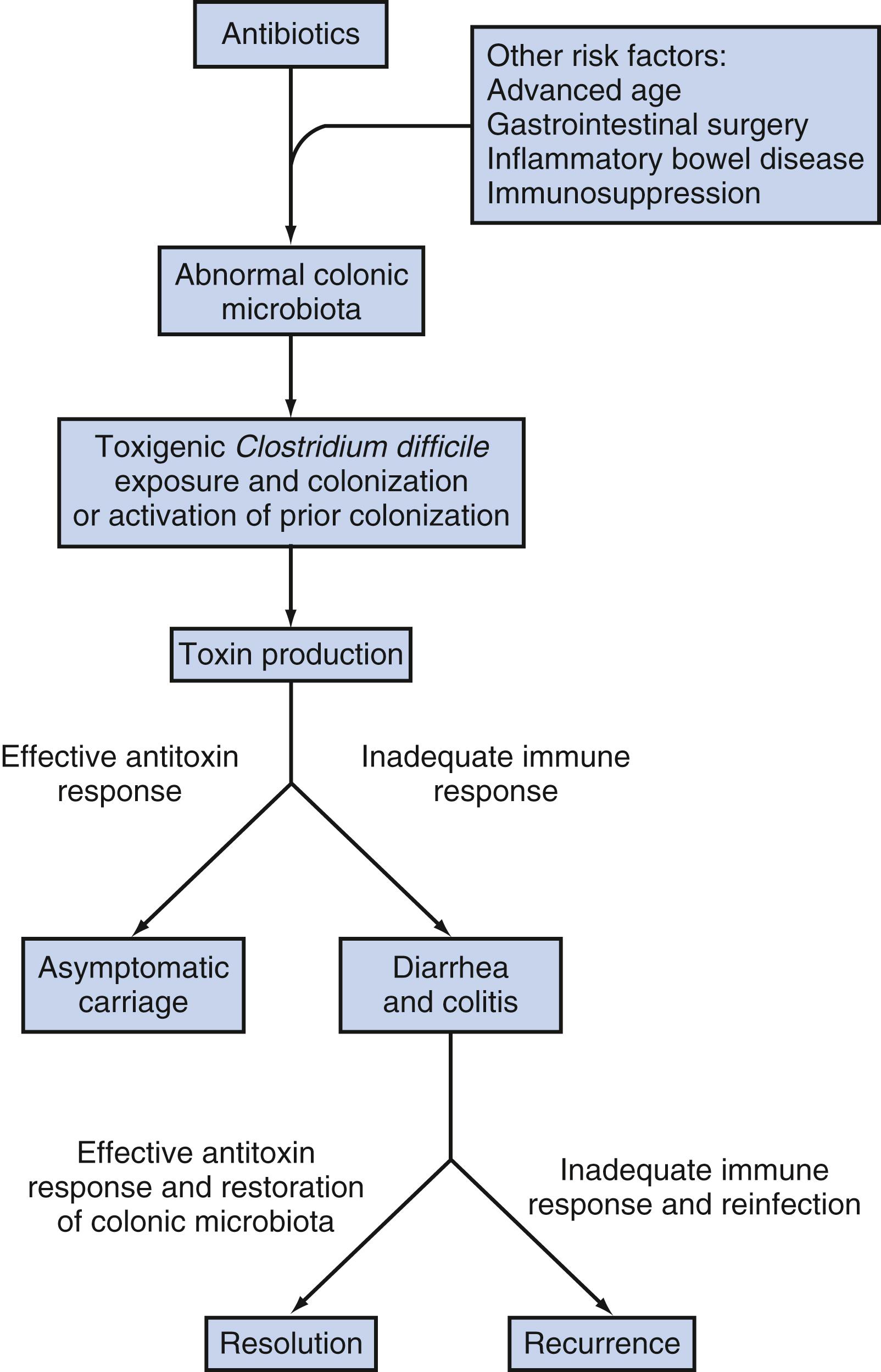Physical Address
304 North Cardinal St.
Dorchester Center, MA 02124
Substantial material from this chapter in the previous edition has been used.
Clostridioides difficile (formerly Clostridium difficile ) is an anaerobic spore-forming, Gram-positive bacillus that was first described as part of a study of the intestinal flora of newborn infants. C. difficile infection (CDI) is a toxin-mediated disease . Once spores reach the colon, they convert to the functional vegetative form in which the organism becomes susceptible to antimicrobial agents and can begin producing exotoxins A (TcdA) and B (TcdB) that are necessary for the development of clinical CDI. Non-toxigenic strains of C. difficile also exist but are not capable of producing CDI.
Disturbances in the intestinal microbiome, often as a result of antibiotic use, facilitate colonization and ultimately infection by C. difficile ( Fig. 190.1 ). Alteration of the intestinal ecosystem decreases resistance to C. difficile colonization. Subsequent ingestion of C. difficile with resultant colonization leads to production of exotoxins TcdA and TcbB, which cause intestinal mucosal injury, inflammation, and diarrhea. Animal model studies demonstrated that these toxins disrupt the cytoskeleton and tight junctions of epithelial cells and cause apoptosis. , TcdB is 10-fold more potent than TcdA in causing human colonic mucosal damage, but both toxins are capable of inducing disease. , In the early 2000s, a hypervirulent strain of C. difficile emerged and caused outbreaks of severe and recurrent CDI in healthcare facilities in the US and Canada. This strain was identified as North American pulsed-field gel electrophoresis type 1 (NAP1), group BI by restriction endonuclease analysis and as ribotype 027 by polymerase chain reaction testing. , The epidemic NAP1 strain has upregulated production of TcdA and TcdB compared with other strains, secondary to genetic differences in regulatory genes, , as well as a third unrelated toxin (binary toxin) that mediates cell surface binding and intracellular translocation. This C. difficile strain has a high level of resistance to fluoroquinolone s . The hypervirulent NAP1 strain of C. difficile has been reported in a small proportion of affected children. ,

The Centers for Disease Control and Prevention (CDC) identifies C. difficile as an urgent antibiotic resistance threat. CDI in adults has become the most common cause of healthcare-associated infection in the US, with excess healthcare costs estimated to be $4.8 billion annually. , In children, CDI increases the cost of hospitalization by nearly $2000 and increases the length of stay by approximately 4 days compared with propensity-score matched controls. Over time, CDI in children has extended from healthcare to community settings. , C. difficile spores are present in asymptomatic neonates, healthy young infants, soil, and healthcare and childcare environments. C. difficile spores are resistant to heat, acidic environments, antibiotics, and most disinfectants, and this resistance allows the organism to survive in the environment for prolonged periods. C. difficile can be acquired from infected or colonized people and from contaminated environments or equipment.
In a study involving active population- and laboratory-based surveillance across 10 geographic areas in the US, the CDC reported that, in 2011, the estimated number of incident CDI cases in the US was 453,000, with an estimated 29,300 deaths; overall, 35% of cases were community-associated. In the same study, the lowest incidence of infection was seen in children 1–17 years of age (24.2 cases per 100,000 population); in this age group, the incidence of community-associated and healthcare-associated CDI was 17.9 and 6.3 per 100,000 persons, respectively. Data suggest the incidence of CDI is increasing among children in ambulatory settings, with 71% of pediatric CDI arising from the community in 2010–2011.
The most important modifiable risk factor for CDI is exposure to antibiotics. CDI has been associated with almost every antibiotic, but high-risk classes include third- and fourth- generation cephalosporins, carbapenems, fluoroquinolones, and clindamycin. , Additional risk factors in children include neoplastic disease and/or receipt of chemotherapy, underlying bowel disease (e.g., inflammatory bowel disease or Hirschsprung disease), solid organ or stem cell transplantation, presence of a gastrostomy or jejunostomy tube, and receipt of proton pump inhibitors or histamine-2 receptor antagonists. ,
Many infants and young children are colonized (with either toxigenic or non-toxigenic strains) without developing symptomatic illness. Colonization rates in infants <12 months of age are variable, the highest exceeding 40% in this age group. Colonization is less common among breastfed infants. , , Colonization rates decrease with increasing age, such that rates in children over 3 years of age are similar to those in healthy adults in the community (∼1-3%). Colonization with toxigenic C. difficile in infancy is associated with a humoral immune response against toxins A and B, with evidence of toxin B neutralization in vitro. It is possible that this natural immunization provides protection against the development of CDI in colonized infants for some period of time, although there may be other additional contributing factors (such as the composition of the intestinal microbiota in infants and young children).
CDI characteristically begins while a child is receiving antimicrobial therapy, but it can occur weeks after treatment is completed. The most common clinical presentation of CDI is mild to moderate diarrhea; some patients have mucus or blood in the stool. Children with pseudomembranous colitis can have diarrhea, fever, abdominal pain or distention, and systemic toxicity such as malaise, anorexia, and dehydration. Severe disease is less common among children than older adults, but complications such as fulminant colitis, toxic megacolon, intestinal perforation, shock, intussusception, pneumatosis, and rectal prolapse are reported rarely. Extraintestinal manifestations of C. difficile are extremely rare, but cases of bacteremia, osteomyelitis, and splenic abscesses are reported.
Become a Clinical Tree membership for Full access and enjoy Unlimited articles
If you are a member. Log in here